The SAO/NASA Astrophysics Data System (ADS) is an online database of over 16 million papers developed by the National Aeronautics and Space Administration (NASA) on astronomy and physics. Abstracts are freely available for most articles, and fully scanned articles may be available in Graphics Interchange Format (GIF) and Portable Document Format (PDF). Hosted papers may be from peer reviewed and/or non-peer-reviewed sources. ADS is managed by the Smithsonian Astrophysical Observatory.

In the fields of Big Bang theory and cosmology, reionization is the process that caused electrically neutral atoms in the universe to reionize after the lapse of the "dark ages".
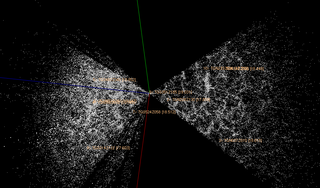
In astronomy, a redshift survey is a survey of a section of the sky to measure the redshift of astronomical objects: usually galaxies, but sometimes other objects such as galaxy clusters or quasars. Using Hubble's law, the redshift can be used to estimate the distance of an object from Earth. By combining redshift with angular position data, a redshift survey maps the 3D distribution of matter within a field of the sky. These observations are used to measure detailed statistical properties of the large-scale structure of the universe. In conjunction with observations of early structure in the cosmic microwave background, these results can place strong constraints on cosmological parameters such as the average matter density and the Hubble constant.

SDSS J090744.99+024506.8 is a short-period variable star in the constellation Hydra. It has a Galactic rest-frame radial velocity of 709 km/s.
Redshift quantization, also referred to as redshift periodicity, redshift discretization, preferred redshifts and redshift-magnitude bands, is the hypothesis that the redshifts of cosmologically distant objects tend to cluster around multiples of some particular value.
John Peter Huchra was an American astronomer and professor. He was the Vice Provost for Research Policy at Harvard University and a Professor of Astronomy at the Center for Astrophysics | Harvard & Smithsonian. He was also a former chair of the United States National Committee for the International Astronomical Union. and past president of the American Astronomical Society.

Margaret J. Geller is an American astrophysicist at the Center for Astrophysics | Harvard & Smithsonian. Her work has included pioneering maps of the nearby universe, studies of the relationship between galaxies and their environment, and the development and application of methods for measuring the distribution of matter in the universe.

In cosmology, galaxy filaments are the largest known structures in the universe, consisting of walls of galactic superclusters. These massive, thread-like formations can commonly reach 50/h to 80/h Megaparsecs — with the largest found to date being the Hercules-Corona Borealis Great Wall at around 3 gigaparsecs (9.8 Gly) in length — and form the boundaries between voids. Due to the accelerating expansion of the universe, the individual clusters of gravitationally bound galaxies that make up galaxy filaments are moving away from each other at an accelerated rate; in the far future they will dissolve.

NGC 4874 is a supergiant elliptical galaxy. It was discovered by the British astronomer Frederick William Herschel I in 1785, who catalogued it as a bright patch of nebulous feature. The second-brightest galaxy within the northern Coma Cluster, it is located at a distance of 109 megaparsecs from Earth.

NGC 3268 is an elliptical galaxy in the constellation Antlia. It is a member of the Antlia Cluster, which lies about 40.7 megaparsecs away. It was discovered on April 18, 1835 by the astronomer John Herschel.

NGC 3258 is an elliptical galaxy in the constellation Antlia. It is a member of the Antlia Cluster, which lies about 40.7 megaparsecs away. It was discovered on May 2, 1834 by John Herschel.
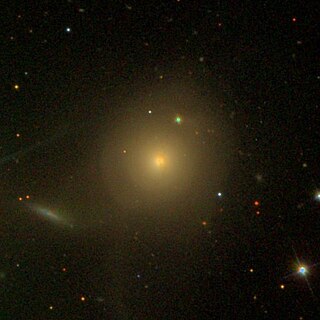
NGC 467 is an unbarred lenticular galaxy in the constellation Pisces. It was discovered on 8 October 1785 by William Herschel.
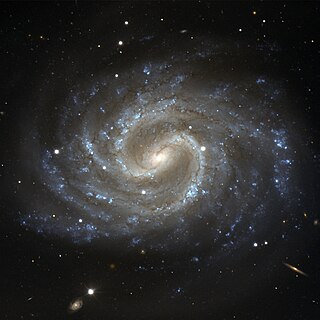
NGC 4535 is a barred spiral galaxy located some 54 million light years from Earth in the constellation Virgo. It is a member of the Virgo Cluster of galaxies and is located 4.3° from Messier 87. The galactic plane of NGC 4535 is inclined by an angle of 43° to the line of sight from the Earth. The morphological classification of NGC 4535 in the De Vaucouleurs system is SAB(s)c, which indicates a bar structure across the core (SAB), no ring (s), and loosely wound spiral arms (c). The inner part of the galaxy has two spiral arms, which branch into multiple arms further away. The small nucleus is of type HII, meaning the spectrum resembles that of an H II region.
Abell 2061 is a galaxy cluster in the constellation of Corona Borealis. On a larger scale still, Abell 2061, along with Abell 2065, Abell 2067, Abell 2079, Abell 2089, and Abell 2092, make up the Corona Borealis Supercluster. It has a northeast southwest orientation and Abell 2067 lies 1.8 megaparsecs north of it.
Abell 2067 is a galaxy cluster in the constellation of Corona Borealis. On a larger scale, Abell 2067, along with Abell 2061, Abell 2065, Abell 2079, Abell 2089, and Abell 2092, make up the Corona Borealis Supercluster. Abell 2061 lies 1.8 megaparsecs south of it and the two are likely interacting.
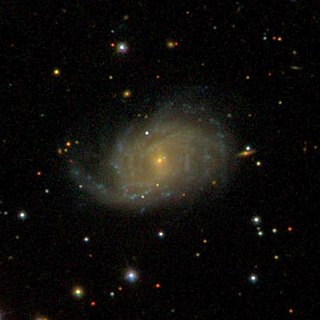
NGC 7046 is a barred spiral galaxy located 193 million light-years away in the constellation of Equuleus. With a high radial velocity of 4,130 km/s, the galaxy is drifting away from the Milky Way. NGC 7046 has an apparent size of 0.990 arcmin, and at its current distance, it has an estimate diameter of 192,639 light years. NGC 7046 has a morphological type of "SBc", which indicates that it is a barred spiral galaxy with a definite bulge.

NGC 5030 is a barred spiral galaxy in the constellation Virgo. The object was discovered on 17 March 1881 by the American astronomer Edward Singleton Holden.
ESO 603-G21 is a candidate polar-ring galaxy.
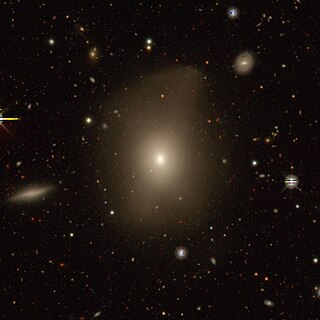
NGC 1570, mistakenly called NGC 1571, is a faint galaxy located in the southern constellation Caelum, the chisel. It has a blue magnitude of 13.2, making it visible through a medium sized telescope. Based on a redshift of z = 0.014760, the object is estimated to be 198 million light years away from the Local Group. It appears to be receding with a heliocentric radial velocity of 4,392 km/s.












